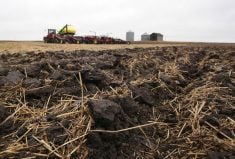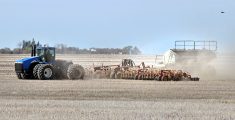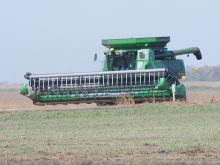Federal government sets a target to reduce the agricultural sector’s greenhouse gas emissions by one percent by 2030
Canada’s latest greenhouse gas emissions reduction plan calls for huge cuts in emissions overall but just a one percent reduction in the agricultural sector.
Still, it offers significant financial assistance to farmers to adopt new practices and buy new technology, a plan with which University of Saskatchewan agricultural economist Tristan Skolrud doesn’t agree.
Overall, the plan outlines spending of $9.1 billion to meet reduction targets of between 40 and 45 percent below 2005 levels by 2030. The biggest cuts would be in the oil and gas, electricity and transportation sectors.
Read Also

Saskatchewan puts crown land auction on hold
Auctions of Saskatchewan crown lease land are once again on hold.
The government’s goal is net zero by 2050.
Agriculture minister Marie-Claude Bibeau said the government will spend money to help farmers transition to greener technologies and practices. However, the plan seems to acknowledge that emissions are unlikely to drop much.
It notes that emissions were 72 megatonnes in 2005 and 73 megatonnes in 2019, or about 10 percent of the national total. The 2030 target is 71 megatonnes.
“Recognizing the important role Canada’s agricultural sector plays in the fight against climate change, actions are focused on expanding support to increase the ability of farmlands to store carbon and by exploring a variety of tools to incent further actions in the agricultural sector,” said the plan. “This includes further investments to support adoption of clean technologies and natural climate solutions to sequester carbon and generate other environmental benefits.”
Bibeau said that with only eight growing seasons left to reach the target, the government is expanding two popular programs.
The Agricultural Clean Technology program was initially $165 million and will increase to $495 million.
“We received so many applications for this program, so I’m very glad that we have been able to triple the amount,” she said.
The recently announced $200 million On-Farm Climate Action Fund, which will see 12 partners across the country deliver financial incentives for cover cropping, rotational grazing and nitrogen management, will be extended beyond the original end date of 2023-24 and get another $470 million.
There is also $100 million for research, and a $150 million resilient agricultural landscapes program that Bibeau said she will be talking to her provincial counterparts about including in the next agricultural policy framework.
The emissions reduction plan also mentioned that an agricultural green plan is in the works, but Bibeau said only that the department is working on other ideas and there is no firm deadline.
“For now, it’s already over $1.5 billion when you add up what we got in December 2020 with the strengthened climate plan and now with the plan to reduce emissions,” she said.
“I have more to submit to my colleagues in the years to come.”
Skolrud said he isn’t a fan of how the government is proceeding.
“In my opinion the government should be trying to maximize the opportunities for farmers, or anyone really, to lower their emissions at the least possible cost,” he said.
Helping farmers buy grain dryers, solar panels and biodigesters answers the vocal complaints about the carbon tax and the fact there aren’t many alternatives for them, such as electric tractors. The government’s response is to do what it considered feasible, he said.
“But from 30,000 feet, when you’re trying to design a policy to reduce a negative externality like greenhouse gas emissions, from the government’s perspective it’s just the wrong target,” Skolrud said. “If it were me, I would try to design programs that allowed farmers to reduce emissions at the lowest possible cost for them, and that’s going to depend on each operation and what they farm and where they’re farming.”
He said there are models and simulations that can show how changing farm practices will change emissions and that is a place to start.
A program on the Agriculture Canada website, Holos, allows farmers, at no cost, to enter farming information such as where they farm, number of acres, what they grow, how much fertilizer they use and other factors.
“It will spit out the best estimate of what your greenhouse gas emissions would be. From there you could say, ‘OK, what if I decreased my nitrogen by 10 kilograms per hectare, or something like that. Now you’re going to produce this many emissions. It is nowhere near perfect, but it does get us closer to the idea that there are cheaper ways to reduce many, many more emissions than say grain drying or solar panels.”
Skolrud said the government may have good intentions but since measuring on-farm emissions is almost impossible it’s also difficult to say how much a farmer should be taxed or subsidized based on a model rather than actual action.
He added that farmers already get favourable treatment compared to other sectors when considering how much they pay versus how much they are emitting.
“At the end of the day, while I do understand the frustrations that farmers have, I always come back to that idea and say, you know what, it could be a lot worse,” Skolrud said.
















